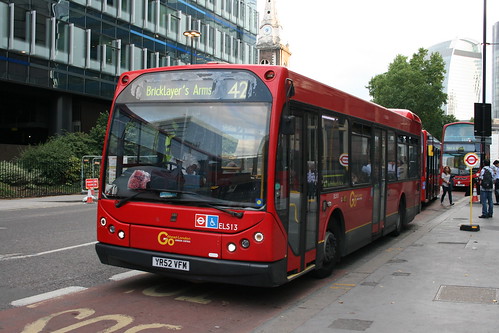
London General ELS13 on Route 42, Aldgate, 08/07/2015
(© Aubrey)
ELS13 is a Scania N94UB/East Lancs OmniTown ordered in early 2002 for the 42 by Durham Travel Services (London Easylink). For most of its life so far, it has been on the 42. This route was gained from Connex/Limebourne back in January 2002. Only a few months later, London Easylink went into liquidation, so Transport for London took over the work of London Easylink as East Thames Buses on 21st August 2002. Once the impounded buses were taken over by TfL as East Thames Buses, these buses stayed with ETB initially at Ash Grove Garage (AG). With the 2005 opening of Mandela Way (MA), the bus and route moved there. Go-Ahead purchased East Thames Buses in 2009, thus the bus and route moved to GAL. These buses gained skirts, just as most other buses were losing theirs. This bus ran on the 42 until 23rd December 2015. Afterwards, the bus was sold on to Trustybus (Galleon Travel) near Harlow. Now, as TB VFM (HXZ9926), this bus runs on Trustybus routes in and around Harlow.
Route 42 itself started out as a cross-London trunk route, running at maximum length from Turnpike Lane to Camberwell Green in the 1930s. Shortened to Aldgate-Camberwell Green from Old Kent Road and Camberwell garages in 1939 due to WWII, the route mainly stuck to the same routing until 1994. From 1951 until 1985, the 42 was with Camberwell Garage. Extensions to Herne Hill and Norwood Garage on Sundays and garage journeys happened in the 1950s, until 1966. RTLs ran on the route from 1951-1966, before being replaced with RTs. To convert the route to OPO, the bus route was converted to single decker with MBs (AEC Merlin), before re-conversion back to double decker with the DMS (Daimler Fleetline) in 1973. 1979 saw a re-conversion back to single decker with the SMS (AEC Swift), lasting less than a year before returning to DMSs. Leyland Titans (T) ran the route between 1980 and 1987, before the first part of privatisation of LT took place, with initial tenders of bus routes coming out in 1987.
London Country South East (formerly NBC London Country, ironically stemmed from the LT country division) won the 42 on tender with Leyland Nationals at a base initially at Catford. The base then moved to Victoria (Battersea Coach Park) in 1987 and Bricklayers Arms in 1989. LCSE was re-branded as Kentish Bus in 1987, and thus the route was operated by Kentish Bus. 1990 saw the route gradually move to Leyton, and gain Leyland Olympian operation on weekends. A full move to Leyton in December 1990 saw the route convert to MCW Metroriders. The route was extended in 1994 to Liverpool Street Station, and new Dennis Dart/Northern Counties Paladin buses were introduced in 1994. April 1997 saw the route move to Limebourne, from Battersea (QB). New Dennis Dart SLF/Plaxton Pointer I were put onto the route, and the route was extended to Denmark Hill. On October 1998, Limebourne went into receivership, and for a time suspended operations. Eventually, the management re-established Limebourne, and the route ran with different Dennis Dart SLF/UVG buses ordered new to replace leased buses in early 1999. 2001 saw the purchase of Limebourne by Connex, and thus the route was run by Connex for a year, before it was moved to Durham Travel Services (London Easylink). London Easylink ran the 42 at Old Kent Road for 8 months, before they went bust. East Thames Buses used new ELSs from London Easylink to run the 42 at Ash Grove (AG) initially, before moving to Mandela Way (MA) in 2005. 2009 saw East Thames Buses be sold off from TfL to Go-Ahead London (London General). The route moved to Camberwell (Q) in 2010, before moving to Mandela Way (MW) in 2012, and returning to Camberwell in 2014, where it is today.
On 1st October 2016, the 42 was extended from Denmark Hill to East Dulwich Sainsbury's, and is now run with Volvo B5LH/MCV EvoSetis from Camberwell Garage.
Post by Aubrey Morandarte
All rights reserved © WLTMTB 2017













